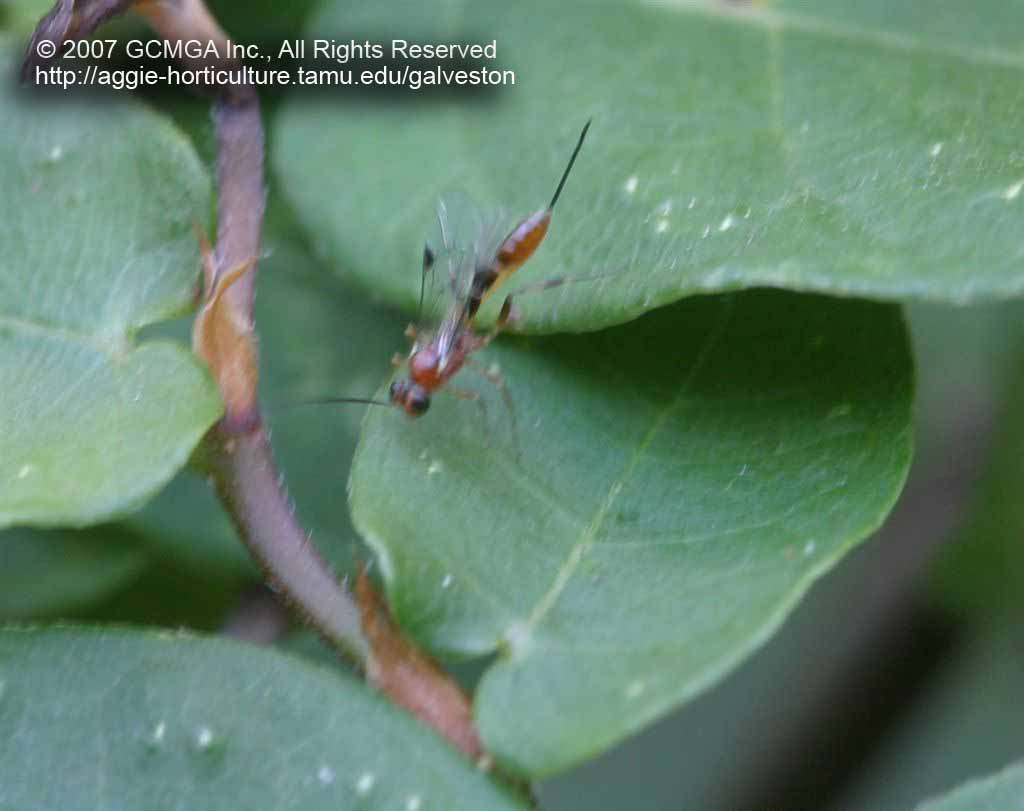Looking around your garden you will find that most insects and other arthropods are not harmful, they are just benignly passing through. Some are even beneficial and will feed on and perhaps prevent or, at the very least, limit pest problems. Beneficials are broadly categorized as either predators or parasitoids. Studies have suggested “that every species of insect that attacks plants is itself attacked by one (or usually more) species of a parasitic wasp.”

Though the term “wasp” may connote the sting of a hornet or yellow jacket, the group called wasps by entomologists is much larger, with the majority of species unable to sting at all. Stingless wasps make up the single largest and most important group of natural enemies of insect pests. There is a superfamily known as Ichneumonoidea, which consists of two families: the Braconidae and the Ichneumonidae, containing over 80,000 different species.
Ichneumonid wasps have been incorrectly called ichneumon flies. This wasp family is found during spring and summer anywhere from forests to urban areas; in the woodlands and in the wetlands of North America. Though solitary, these insects can be seen during the day searching for hosts or feeding on the nectar of flowers, shrubs, and trees, flying around native blossoms. Ichneumonid wasps prefer members of the carrot family.
Ichneumonid wasps are one of the largest families with more than 3,300 recognized species in North America. All ichneumonids are parasitoids and they parasitize a lot of insect groups, though most species attack a fairly narrow range of hosts as species are host-specific. Most ichneumonids are internal parasitoids at the immature stage of the host. They develop in or on a single host from eggs or larvae deposited by an adult female. Upon hatching, the larvae feed either externally or internally, killing the host as they are ready to pupate. Common hosts are the larvae and pupae of Coleoptera (beetles), Hymenoptera (bees & wasps), and Lepidoptera (moths & butterflies).
Without stating the obvious, members of the Ichneumonidae family are wasp-like in appearance. Though ichneumonid wasps are one of the larger parasitic wasps, adults vary in color, form, markings, and size. Generally speaking, they are elongate and slender but, again, their size is somewhat host-dependent. Ichneumonid wasps range from less than 1/8 of an inch in length to almost 5 inches including their ovipositor. Some are black, brown, or tan, while others are brightly colored. Ichneumonids are sometimes referred to as “scorpion wasps” for the extreme length, narrowness, and curve of their abdomens, which may be segmented with a lot of yellow markings.
The main way to distinguish an ichneumonid wasp is by the details of their wing venation (the arrangement of a system of veins). Their wings may be shaded with blue and brown colors. They have noticeably long antennae with 16 or more segments and long legs. Ichneumon wasps of both sexes use their antennae by “tapping” as they wander over logs, tree trunks, and grass stems. Males are listening for newly hatched females to mate with.
Gravid females are listening for larvae to lay eggs on. Stinging wasps have an analogous structure, commonly called a “stinger” that has been modified exclusively for defense. The non-stinging female ichneumonid wasps also appear to have a stinger; however, this is actually an ovipositor or egg-laying appendage. Often even longer than her body, these ovipositors are quite sturdy, long, and conspicuous.
Female ichneumonid wasps do not construct a nest. Instead, she finds a host by first locating the host’s food source. Next she begins searching surrounding surfaces for it with her antennae which can detect vibrations made by the sounds a host prey makes when its feeding. Once discovered, female ichneumonid wasps will lay their egg on, near, or inside the body of a host species. Some ichneumonid species use their ovipositor to drill into the surface until she finds the larvae and injects an egg through the bored hole she has made. Some inject their eggs with the ovipositor directly into a host’s body. Other female species have long abdomens, which are used to reach grubs that burrow into bark. She then utilizes that long abdomen to reach in and lay eggs on or into the grub host.
Regardless of species or method, and the egg is laid, she flies away. After the egg hatches, the larvae feed either externally on the host or burrow into its body. The larval stage varies from about ten days to several weeks. Some hosts can survive until the developing larva is fully-grown, at which time the larvae either pupates inside the host or spins a cocoon outside the host’s remains. Other host species die quicker. Many ichneumonid species have one generation per year while others have two, three, or more generations annually.
| Host Species for Some Ichneumonid Wasps | |
| Ichneumonid Species | Host |
| Bathyplectes anurus | Alfalfa weevil |
| Bathyplectes curculionis | Alfalfa weevil |
| Collyria coxator | Wheat stem sawfly |
| Diadegma insulare | Diamondback moth |
| Eriborus terebrans | European corn borer |
| Hyposoter spp. | Cutworms, loopers |
| Lathrolestes nigricollis | Birch leafminer |
| Patracloides mantanus | Cabbage looper |
| Scambus applopa | Nantucket pine tip moth |
Ichneumonids wasps are extremely important in the natural control of plant pests. They use a motley muster of insects and arachnids as their hosts and play an essential role in the majority of ecosystems. Ichneumonids have been used successfully as biocontrol agents and there is a huge potential in managed biocontrol programs. Unfortunately, not enough ichneumon species have been studied and further comprehensive research is needed in natural, as well as, biological control.
We need to learn to recognize these beneficials as well as appreciate and conserve them. When insecticides are warranted, please only choose ones that are less likely to harm insect predators and parasitoids.